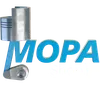Connecting elements – precision links for engine systems
Connecting elements are critical components that join mechanical parts within engine assemblies, industrial machines or control systems. They ensure stability, alignment, and force transmission between moving or static structures. High-quality connecting elements are essential for safety, performance, and long-term durability in demanding applications.
Choose from following:
Function and benefits
Used across a wide range of applications, connecting elements form the mechanical link between components such as housings, shafts, brackets, or pipes. A well-designed connecting piece or assembly ensures:
- Secure connection with high mechanical strength
- Precise alignment of engine or machine components
- Resistance to vibration, temperature, and environmental stress
Especially in engine systems, each connecting part must maintain tight tolerances to prevent misalignment, leakage or stress-related damage.
Applications and types
Connecting pieces can include flanges, couplings, clamps, threaded adapters or bushings – depending on the system and function. In engines, they are often used between cylinder heads and manifolds, pumps and piping, or sensors and control housings. Connecting parts may also be part of flexible or modular assembly systems, allowing for quick maintenance or customization.
Materials and availability
Connecting elements are typically made from stainless steel, aluminum, brass, or high-performance polymers – selected based on load, media, pressure and temperature requirements. Corrosion resistance, weight and sealing properties are crucial in marine or chemical environments. We offer OEM-connecting pieces for MTU, MAN, Deutz, Volvo Penta and MWM engine systems – with fast delivery and industrial-grade quality.

FAQ
What are connecting elements used for?
Connecting elements are used to join mechanical components together in a stable, secure and functional way. They transmit force, enable movement or sealing, and maintain alignment in engines and industrial assemblies.
How do I choose the right connecting piece?
The right connecting piece depends on the application, pressure, material compatibility, and dimensional fit. Consider mechanical load, temperature range, and corrosion exposure when selecting a component.
Are connecting parts standardized?
Many connecting parts follow international standards (e.g. DIN, ISO) for threads, flanges and couplings, but specific systems or engines may require OEM-specific elements. Always check compatibility with the system in use.
